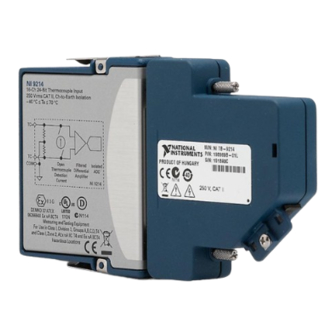
National Instruments NI 9214 Getting Started Manual
16 tc, ±78 mv, 24 bit, 68 s/s aggregate, isothermal terminal block
Hide thumbs
Also See for NI 9214:
- Operating instructions and specifications (45 pages) ,
- Manual (11 pages) ,
- Getting started manual (22 pages)
Table of Contents
Advertisement
Quick Links
Advertisement
Table of Contents

Summary of Contents for National Instruments NI 9214
- Page 1 NI-9214...
- Page 2 GETTING STARTED GUIDE NI 9214 16 TC, ±78 mV, 24 Bit, 68 S/s Aggregate, Isothermal Terminal Block...
-
Page 3: Safety Guidelines
This document explains how to connect to the NI 9214. Before you begin, complete the software and Note hardware installation procedures in your chassis documentation. The guidelines in this document are specific to Note the NI 9214. The other components in the system might not meet the same safety ratings. -
Page 4: Safety Guidelines For Hazardous Voltages
You must use the TB-9214 included with the NI 9214 to ensure that the terminals are not accessible. NI 9214 Getting Started Guide | © National Instruments | 3... -
Page 5: Safety Voltages
This category refers to local-level electrical distribution, such as that provided by a standard wall outlet, for example, 115 V for U.S. or 230 V for Europe. Do not connect the NI 9214 to signals or use Caution for measurements within Measurement Categories III or IV. -
Page 6: Safety Guidelines For Hazardous Locations
Safety Guidelines for Hazardous Locations The NI 9214 is suitable for use in Class I, Division 2, Groups A, B, C, D, T4 hazardous locations; Class I, Zone 2, AEx nA IIC T4 and Ex nA IIC T4 hazardous locations; and nonhazardous locations only. - Page 7 Zone 2 hazardous locations, in ambient temperatures of -40 °C ≤ Ta ≤ 70 °C. If you are using the NI 9214 in Gas Group IIC hazardous locations, you must use the device in an NI chassis that has been evaluated as Ex nC IIC T4, Ex IIC T4, Ex nA IIC T4, or Ex nL IIC T4 equipment.
-
Page 8: Electromagnetic Compatibility Guidelines
To minimize interference with radio and television reception and prevent unacceptable performance degradation, install and use this NI 9214 Getting Started Guide | © National Instruments | 7... -
Page 9: Special Conditions For Marine Applications
In order to meet the EMC requirements for Caution marine applications, install the product in a shielded enclosure with shielded and/or filtered power and input/output ports. In addition, take precautions when designing, selecting, and installing measurement probes 8 | ni.com | NI 9214 Getting Started Guide... -
Page 10: Preparing The Environment
EMC performance is attained. Preparing the Environment Ensure that the environment in which you are using the NI 9214 meets the following specifications. Operating temperature -40 °C to 70 °C (IEC 60068-2-1, IEC 60068-2-2) - Page 11 TC0+ TC5- TC0- TC6+ TC1+ TC6- TC1- TC7+ TC10+ TC2+ TC13+ TC7- TC10- TC2- TC13- TC8+ TC11+ TC3+ TC14+ TC8- TC11- TC3- TC14- TC11+ TC9+ TC4+ TC15+ TC11- TC9- TC4- TC15- 10 | ni.com | NI 9214 Getting Started Guide...
- Page 12 Table 1. Signal Descriptions Signal Description Common reference connection Positive thermocouple connection Negative thermocouple connection NI 9214 Getting Started Guide | © National Instruments | 11...
-
Page 13: Thermocouple Connections
• All thermocouples are floating • All thermocouples are referenced to the same common-mode voltage • One thermocouple is reference to a common-mode voltage and all other thermocouples are floating 12 | ni.com | NI 9214 Getting Started Guide... - Page 14 NI 9214 Connection Guidelines • Make sure that devices you connect to the NI 9214 are compatible with the module specifications. • The shield grounding methodology can vary depending on the application.
- Page 15 Minimize adjacent heat sources and air flow across the terminals. • Keep the ambient temperature as stable as possible. • Make sure the NI 9214 terminals are facing forward or upward. • Keep the NI 9214 in a stable and consistent orientation. •...
- Page 16 (30 AWG to 20 AWG) wire with 5.1 mm (0.2 in.) of the inner insulation stripped and 51 mm (2.0 in.) of the outer insulation stripped • Zip tie • Screwdriver NI 9214 Getting Started Guide | © National Instruments | 15...
- Page 17 What to Do 16 | ni.com | NI 9214 Getting Started Guide...
- Page 18 1. Connect the TB-9214 to the NI 9214 front connector. 2. Tighten the jackscrews to a maximum torque of 0.4 N · m (3.6 lb · in.). Do not overtighten the jackscrews. NI 9214 Getting Started Guide | © National Instruments | 17...
-
Page 19: Where To Go Next
NI 9214 Datasheet NI 9214 Datasheet NI-RIO Help NI-DAQmx Help LabVIEW FPGA Help LabVIEW Help RELATED INFORMATION C Series Documentation Services & Resources ni.com/services ni.com/info cseriesdoc Located at ni.com/manuals Installs with the software 18 | ni.com | NI 9214 Getting Started Guide... -
Page 20: Worldwide Support And Services
You can obtain the DoC for your product by visiting ni.com/certification. If your product supports calibration, you can obtain the calibration certificate for your product at ni.com/calibration. NI 9214 Getting Started Guide | © National Instruments | 19... - Page 21 U.S. Government Customers: The data contained in this manual was developed at private expense and is subject to the applicable limited rights and restricted data rights as set forth in FAR 52.227-14, DFAR 252.227-7014, and DFAR 252.227-7015. © 2010—2016 National Instruments. All rights reserved. 375138C-01 Mar16...













Need help?
Do you have a question about the NI 9214 and is the answer not in the manual?
Questions and answers